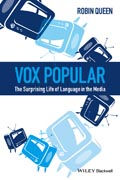
Our favorite movies and TV shows feature indelible characters who tell us about themselves not just in what they say but in how they say it. The creative decisions behind these voices—such as what accent or dialect to use—offer rich data for sociolinguistic study. Ideal for students of language variation as well as general readers interested in media, Vox Popular is an engaging tour through the major issues of sociolinguistic study as heard in the voices from mass media.• Provides readers with a unified and accessible picture of the interrelationships between language variation and the mass media• Presents detailed original analyses of multiple audiovisual media sources• Includes a broad methods chapter covering quantitative and qualitative methods in a style not available in any other textbook• All theoretical terms are accessibly explained, with engaging examples, making it suitable for non–academics as well as undergraduate students• Incorporates pedagogical textboxes throughout and includes sections dedicated to developing practical skills for the field INDICE: .Preface and Acknowledgments vii.A Note on the Linguistic Conventions Used in Vox Popular x.Keywords Found in Each Chapter xiv.1 Language in a Mediated World 1.Mad Men in a Modern Family World 1.Why Does a Linguist Care about Mad Men or Modern Family? 3.Narrative Media as a Site for Linguistic Exploration 12.Language Variation in the Narrative Media 20.2 Exploring Language and Language Variation 25.Introduction 25.Languages and Dialects 27.The Components of a Grammar 32.All the Systems Work as a System 34.Systems of Variation 40.Language Change 47.3 Studying Language Variation in the Media 55.Introduction 55.Formulating a Research Question 56.Turning Narrative Media into Data 57.Analytic Orientation 58.Transcribing Your Data 61.Coding Your Data 66.Constructing a Corpus 69.Quantitative Methods 70.Qualitative Methods 75.Triangulating Your Evidence with Different Analytic Approaches 82.4 Dimensions of Variation 85.Introduction 85.Non–Linguistic/Linguistic 90.Spoken/Written 93.Non–Standard/Standard 97.Informal/Formal 101.Unplanned/Planned 104.Local/Global 107.Private/Public 110.Putting It All Together 114.5 Making Language Variation Meaningful 119.Introduction 119.Meaning 120.Indexical Meaning 124.Ideology 130.Ideology about Language 133.Ideology, Indexicality, and Power 138.6 Language Variation and Characterization 154.Introduction 154.Characterization and Language 156.Realness and Authenticity 160.Identity and Identification 163.Relational Identity 164.Norms and Types 168.Social Personae 172.Indexical Authenticity 176.7 Language as Narrative Action 183.Introduction 183.Performance and Speech Acts 185.Language as a Plot Device 193.Switching as Action 196.Taboo Language as Action 205.8 Connecting to the Audience 221.Introduction 221.Audiences 222.Audience Design 226.Setting Expectations for Viewers 230.Enregisterment 236.Stylization 242.Interacting with Audiovisual Media 246.The End 253.Index 258
- ISBN: 978-0-470-65991-5
- Editorial: John Wiley & Sons
- Encuadernacion: Cartoné
- Páginas: 288
- Fecha Publicación: 19/01/2015
- Nº Volúmenes: 1
- Idioma: Inglés
